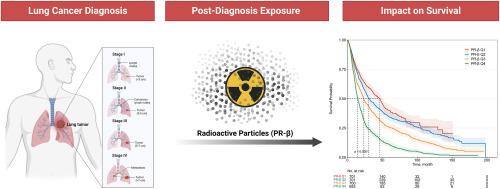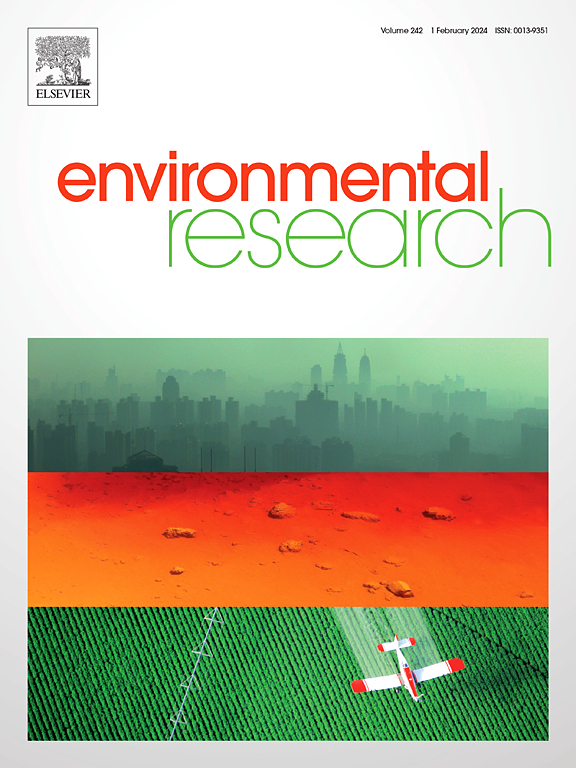环境中的β粒子放射性与肺癌存活率:波士顿肺癌研究的结果。
IF 7.7
2区 环境科学与生态学
Q1 ENVIRONMENTAL SCIENCES
引用次数: 0
摘要
背景:众所周知,暴露于电离辐射会增加罹患肺癌的风险。然而,与环境粒子空气污染相关的环境辐射对肺癌存活率影响的研究却很有限。我们研究了确诊后环境β粒子放射性(PR-β)与肺癌存活率之间的关系:波士顿肺癌生存率(BLCS)队列由美国波士顿马萨诸塞州总医院(MGH)和丹娜-法伯癌症研究所(DFCI)的组织学确诊患者组成。我们估算了2001年至2017年居住地邮政编码的环境PR-β暴露量。在控制协变量的情况下,我们构建了 Cox 比例危险模型来估算环境 PR-β 与生存结果之间的危险比 (HR):分析包括 2795 名信息完整的患者,随访时间为 97,330 人月。在调整协变量(包括诊断时的年龄、性别、种族、吸烟、分期、组织学和调整后的总收入)的情况下,PR-β的四分位数间距(IQR)增加与总生存率(HR:1.63,95% CI:1.52,1.76)、5年生存率(HR:1.33,95% CI:1.23,1.44)和3年生存率(HR:1.22,95% CI:1.12,1.33)的降低显著相关。在对估计的住宅氡暴露进行额外调整后,也发现了类似的关联。此外,早期患者与PR-β暴露相关的生存率明显较低(HR:2.16,95% CI:1.84,2.52):本研究的结果提供了新的证据,表明肺癌确诊后暴露于放射性粒子环境可能会对患者的生存产生明显影响,尤其是早期患者。本文章由计算机程序翻译,如有差异,请以英文原文为准。

Ambient beta particle radioactivity and lung cancer survival: Results from the Boston Lung Cancer Study
Background
Exposure to ionizing radiation is known to increase the risk of lung cancer. However, studies on the effect of environmental radiation associated with ambient particle air pollution on lung cancer survival are limited. We investigated the association between ambient beta particle radioactivity (PR-β) after a diagnosis and lung cancer survivals.
Methods
The Boston Lung Cancer Survival (BLCS) cohort consisted of histologically confirmed patients enrolled at Massachusetts General Hospital (MGH) and the Dana-Farber Cancer Institute (DFCI) in Boston, U.S. The primary outcomes included overall survival, 5-year survival, and 3-year survival probability. We estimated ambient PR-β exposure at the ZIP code of residence from 2001 through 2017. Cox-proportional hazards models were constructed to estimate hazard ratios (HRs) for the associations between ambient PR-β and survival outcomes while controlling for covariates.
Results
The analysis included 2795 patients with complete information, with 97,330 person-months of follow-up. The interquartile range (IQR) increase in PR-β was significantly associated with worse overall survival (HR:1.63, 95% CI:1.52, 1.76), 5-year survival (HR:1.33, 95% CI:1.23, 1.44), and 3-year survival (HR:1.22, 95% CI:1.12, 1.33) while adjusting for covariates, including age at diagnosis, sex, race, smoking, stage, histology, and adjusted gross income. Similar associations were found while additionally adjusting for the estimated residential radon exposure. In addition, the survival associated with PR-β exposure was significantly worse for patients in the early stages (HR:2.16, 95% CI:1.84, 2.52).
Conclusion
The findings from this study provide new evidence suggesting that environmental exposure to radioactive particles after lung cancer diagnosis may have a pronounced effect on survival, particularly in patients with early stages.
求助全文
通过发布文献求助,成功后即可免费获取论文全文。
去求助
来源期刊

Environmental Research
环境科学-公共卫生、环境卫生与职业卫生
CiteScore
12.60
自引率
8.40%
发文量
2480
审稿时长
4.7 months
期刊介绍:
The Environmental Research journal presents a broad range of interdisciplinary research, focused on addressing worldwide environmental concerns and featuring innovative findings. Our publication strives to explore relevant anthropogenic issues across various environmental sectors, showcasing practical applications in real-life settings.
 求助内容:
求助内容: 应助结果提醒方式:
应助结果提醒方式:


